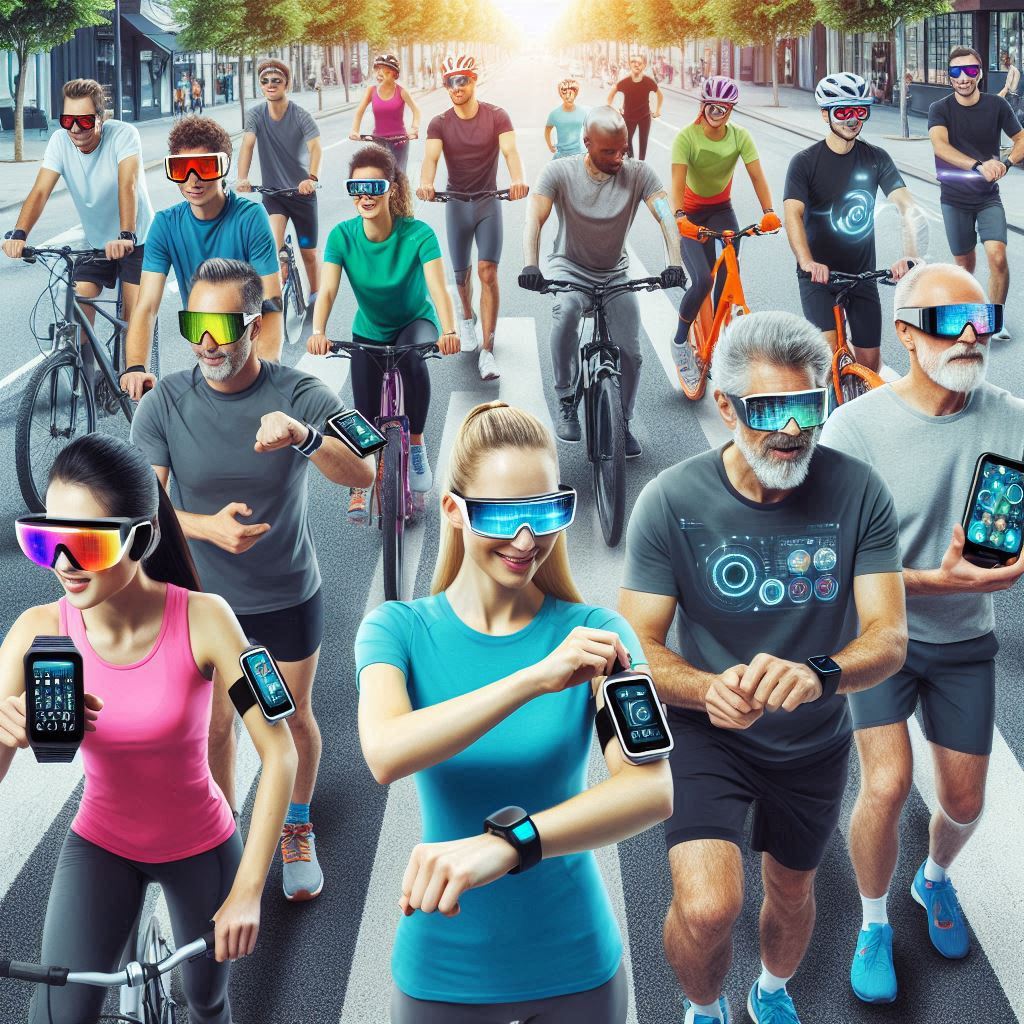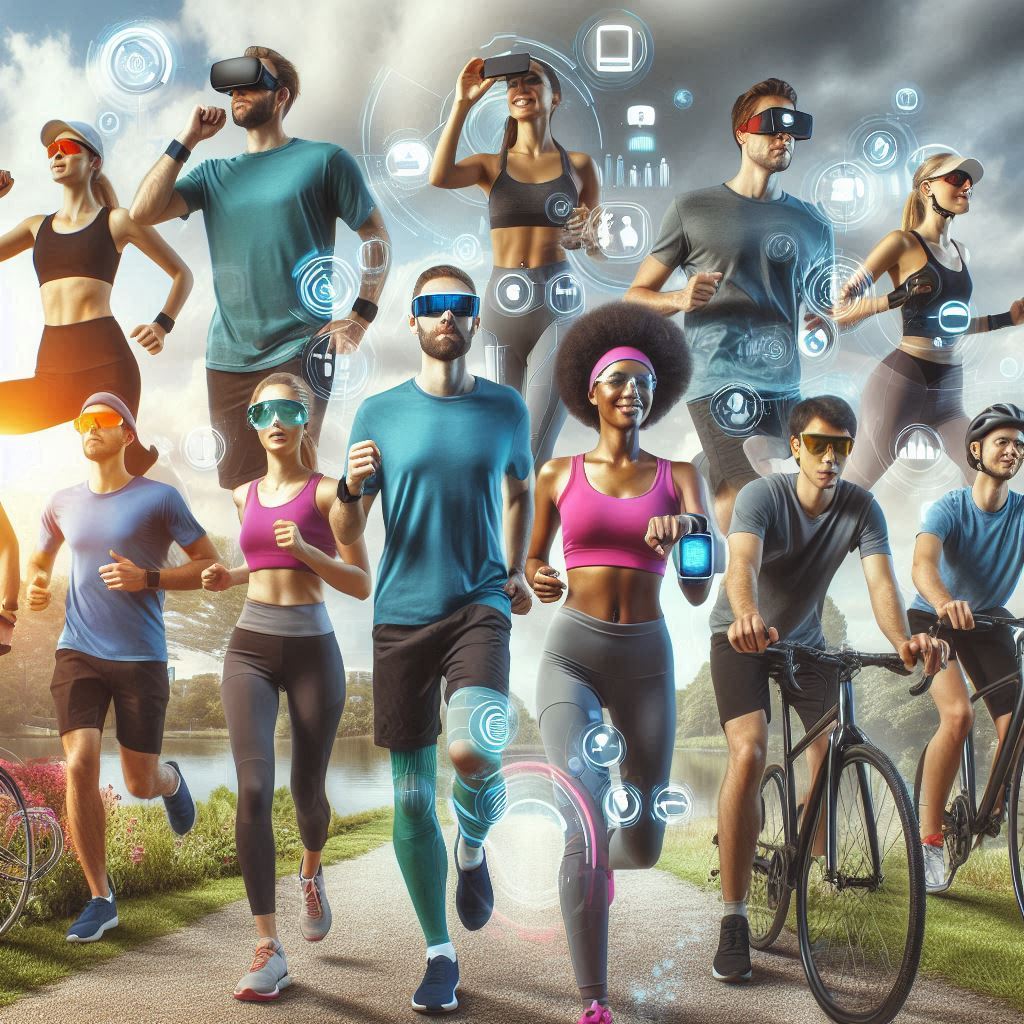The wearable technology landscape in the United States is undergoing a transformative evolution, driven by rapid advancements in sensor technology, artificial intelligence, and consumer demand for health-focused devices.
The global wearable technology market size is expected to grow from USD 70.30 billion in 2024 to USD 152.82 billion by 2029, growing at a CAGR of 16.8% during the forecast period.

Evolution of Wearable Technology in the United States and Its Growing Significance
Wearable technology has transitioned from niche fitness trackers to sophisticated devices that integrate seamlessly into daily life. In the early 2000s, wearables were primarily pedometers and basic heart rate monitors. Today, smartwatches, augmented reality glasses, and health-monitoring patches dominate the market, reflecting the dynamic growth in the Future of USA Wearable Technology Industry. The U.S. has been a pioneer in this space, with companies like Apple, Fitbit, and Garmin setting global standards. The industry’s significance lies in its ability to empower consumers with real-time health data, enhance productivity, and redefine entertainment experiences. As health consciousness rises post-COVID-19, the demand for devices that monitor vital signs like heart rate, blood oxygen, and glucose levels has surged, positioning the Future of USA Wearable Technology Industry as a cornerstone of modern healthcare and lifestyle innovation.
The integration of wearables into telemedicine and remote patient monitoring has further amplified their relevance. The Centers for Medicare & Medicaid Services (CMS) relaxed telemedicine regulations during the pandemic, accelerating adoption and highlighting the role of wearables in reducing in-person visits. This shift underscores the transformative potential of the Future of USA Wearable Technology Industry in reshaping healthcare delivery. Additionally, the consumer electronics segment, led by smartwatches and wireless earbuds, continues to attract a diverse user base, including athletes, professionals, and tech enthusiasts, further solidifying the industry’s growth trajectory.
Technological Innovations Driving the Future of USA Wearable Technology Industry Forward
The Future of USA Wearable Technology Industry is being propelled by cutting-edge innovations that enhance device functionality and user experience. Advances in sensor technology have enabled wearables to measure complex physiological metrics, such as electrocardiograms (ECGs), blood glucose levels, and stress biomarkers, with unprecedented accuracy. For instance, devices like the Apple Watch Series 10 and Fitbit Versa 4 offer features like continuous glucose monitoring and heart rate variability analysis, catering to individuals with chronic conditions like diabetes. These advancements reflect the industry’s shift toward personalized healthcare, a key driver in the Future of USA Wearable Technology Industry.
Artificial intelligence (AI) and machine learning are also revolutionizing wearables by enabling predictive analytics and personalized feedback. AI-powered algorithms analyze data from wearables to provide actionable insights, such as detecting early signs of atrial fibrillation or recommending lifestyle changes based on sleep patterns. The integration of 5G connectivity ensures real-time data transfer, enhancing the performance of wearables in remote monitoring and augmented reality applications. Moreover, the development of flexible electronics and liquid metal-based conductors is making devices thinner, softer, and more comfortable, addressing user concerns about wearability and comfort in the Future of USA Wearable Technology Industry.
Innovations in battery efficiency and energy harvesting are tackling one of the industry’s persistent challenges: power supply. Researchers are exploring solar-powered wearables and kinetic energy harvesting to extend battery life, ensuring devices can operate continuously without frequent recharging. These technological breakthroughs are not only enhancing user experience but also expanding the applications of wearables in industries like logistics, gaming, and outer space missions, positioning the Future of USA Wearable Technology Industry at the forefront of global technological advancement.
Key Trends Shaping the Future of USA Wearable Technology Industry in the Coming Decade
Several trends are shaping the trajectory of the Future of USA Wearable Technology Industry, reflecting evolving consumer preferences and technological capabilities. One prominent trend is the rise of discreet and stylish wearables that blend seamlessly with fashion. Jewelry-like devices, such as smart rings and bracelets, are gaining popularity for their aesthetic appeal and functionality. Companies like McLEAR have introduced NFC-enabled payment rings, combining contactless payments with hypoallergenic materials, catering to consumers seeking convenience and style in the Future of USA Wearable Technology Industry.
Another significant trend is the integration of augmented reality (AR) and virtual reality (VR) into wearables. AR-enabled smart glasses, like those developed by Vuzix, overlay digital information onto the real world, enhancing navigation, communication, and industrial training. VR headsets are evolving to offer immersive experiences in gaming and virtual meetings, driven by improvements in resolution and comfort. These developments are expanding the scope of wearables beyond health and fitness, positioning the Future of USA Wearable Technology Industry as a key player in the metaverse and immersive technology ecosystems.
Download PDF Brochure for More Info @ https://www.marketsandmarkets.com/pdfdownloadNew.asp?id=983
Sustainability is also emerging as a critical focus, with manufacturers adopting eco-friendly materials and recyclable components. The use of biodegradable polymers and sustainable production processes is addressing environmental concerns, aligning with consumer demand for responsible technology. Additionally, the growing adoption of wearables in workplace wellness programs is enhancing employee health monitoring and productivity, further driving demand in the Future of USA Wearable Technology Industry. These trends collectively highlight the industry’s versatility and its potential to influence diverse sectors.

The Role of Healthcare in Expanding the Future of USA Wearable Technology Industry
Healthcare is a pivotal sector driving the Future of USA Wearable Technology Industry, with wearables playing an increasingly vital role in preventive care and chronic disease management. Devices like the Lief Therapeutics patch, which monitors stress through heart rate variability, and Corvolution’s Mesana sensor patch, which measures ECG and other vital signs, exemplify the industry’s shift toward real-time health monitoring. These devices provide comprehensive health insights, enabling clinicians to make informed decisions without requiring frequent office visits, a trend accelerated by the COVID-19 pandemic.
The Future of USA Wearable Technology Industry is also benefiting from the growing acceptance of wearables in clinical research. Large-scale studies, such as Apple’s Heart and Movement Study, leverage wearable data to generate insights into population health trends. Wearables offer objective, continuous data collection, surpassing the limitations of self-reported outcomes. For instance, Fitbit devices have been used to digitally phenotype asthma in children, providing clinicians with detailed metrics on physical activity, sleep, and environmental triggers. This data-driven approach is enhancing the precision of healthcare delivery and positioning the Future of USA Wearable Technology Industry as a catalyst for medical innovation.
However, challenges remain, including ensuring data accuracy and regulatory compliance. The U.S. Food and Drug Administration (FDA) is developing frameworks to evaluate the safety and efficacy of wearable health devices, ensuring they meet clinical standards. Addressing these challenges will be crucial for sustaining consumer trust and expanding the adoption of wearables in healthcare, further solidifying the Future of USA Wearable Technology Industry’s role in transforming medical care.
Consumer Behavior and Market Dynamics Influencing the Future of USA Wearable Technology Industry
Consumer behavior is a critical factor shaping the Future of USA Wearable Technology Industry, with health consciousness and technological literacy driving adoption. Post-pandemic, Americans have prioritized health monitoring, boosting sales of devices like the Fitbit Versa 4 and AirPods Max, which offer features like oxygen level tracking and calorie counting.
Brand loyalty and affordability are key considerations for consumers, with companies like Apple and Samsung dominating the premium segment, while startups like Boat and Noise target cost-conscious buyers with feature-rich alternatives. The Future of USA Wearable Technology Industry is also seeing increased demand from diverse user groups, including athletes, gamers, and professionals, who value wearables for performance tracking, immersive experiences, and productivity enhancement. For example, smart shoes and sunglasses are gaining traction among sports enthusiasts, offering real-time metrics on stride and UV exposure.
Market dynamics, such as strategic partnerships and mergers, are further fueling growth. Tech giants are collaborating with healthcare providers and financial institutions to integrate wearables into broader ecosystems, such as contactless payments and telehealth platforms. These partnerships are expanding the functionality of wearables and enhancing their appeal, ensuring the Future of USA Wearable Technology Industry remains competitive and innovative.
Challenges and Barriers Facing the Future of USA Wearable Technology Industry
Despite its promising outlook, the Future of USA Wearable Technology Industry faces several challenges that could impede growth. Data privacy and security are paramount concerns, with 40% of Americans expressing apprehension about how their health data is stored and shared, according to a 2021 Deloitte survey. High-profile data breaches, such as the exposure of 61 million Fitbit and Apple records in 2021, have underscored the need for robust security measures. While regulations like HIPAA provide some protection, not all wearable data falls under its purview, necessitating stronger industry standards to safeguard consumer trust in the Future of USA Wearable Technology Industry.
Accuracy and reliability of wearable data are also critical issues. Factors like sensor calibration and device placement can introduce errors, affecting the quality of insights provided to users and clinicians. The lack of standardized assessment methods for wearability—encompassing comfort, usability, and integration—further complicates device design. Qualitative studies dominate the field, but quantitative research is needed to establish validated design criteria, a gap that must be addressed to ensure the Future of USA Wearable Technology Industry delivers reliable and user-friendly products.
User retention is another challenge, with studies showing that 32% of users abandon wearables after six months due to perceived lack of value or cumbersome interfaces. Improving user experience through intuitive designs and personalized feedback will be essential for sustaining engagement in the Future of USA Wearable Technology Industry. Addressing these barriers will require collaboration among manufacturers, regulators, and researchers to ensure wearables meet consumer expectations and clinical standards.
Opportunities for Growth and Innovation in the Future of USA Wearable Technology Industry
The Future of USA Wearable Technology Industry is ripe with opportunities for growth and innovation, particularly in healthcare, fashion, and workplace applications. The integration of wearables with the Internet of Things (IoT) is creating interconnected ecosystems that enhance functionality. For example, wearables linked to smart home devices can adjust lighting or temperature based on stress levels, offering a holistic approach to wellness. This interconnectedness is driving demand and opening new revenue streams in the Future of USA Wearable Technology Industry.
The metaverse presents another exciting opportunity, with wearables like AR glasses and VR headsets enabling immersive experiences in education, entertainment, and remote collaboration. Companies are investing in mixed reality applications that combine AR and VR, offering innovative solutions for industrial training and virtual tourism. These advancements are expanding the scope of the Future of USA Wearable Technology Industry, attracting investment and fostering cross-industry partnerships.

Regulatory and Ethical Considerations Impacting the Future of USA Wearable Technology Industry
Regulatory and ethical considerations are critical to the sustainable growth of the Future of USA Wearable Technology Industry. The FDA is actively developing guidelines for wearable health devices, focusing on safety, efficacy, and data integrity. These regulations aim to ensure that wearables used in clinical settings meet rigorous standards, protecting consumers and healthcare providers. However, the rapid pace of innovation often outstrips regulatory frameworks, creating challenges for manufacturers seeking approval in the Future of USA Wearable Technology Industry.
Ethically, the industry must address concerns about data ownership and consent. Consumers are increasingly wary of third-party data sharing, particularly when personal health information is involved. Transparent data policies and user-controlled privacy settings are essential for building trust. Additionally, ensuring equitable access to wearable technology is a priority, as high costs can exclude low-income populations from benefiting from health-monitoring devices. Addressing these ethical considerations will be crucial for the Future of USA Wearable Technology Industry to achieve widespread acceptance and impact.
The Role of Research and Development in Sustaining the Future of USA Wearable Technology Industry
Research and development (R&D) are the backbone of the Future of USA Wearable Technology Industry, driving innovation and addressing technical challenges. Universities and research institutions, such as Tampere University and the University of California, Los Angeles, are advancing wearable sensor technology and data analytics. Collaborative projects, like the H2020 MCSA A-WEAR initiative, focus on privacy-aware positioning and machine learning applications, enhancing the functionality of wearables in the Future of USA Wearable Technology Industry.
Industry-sponsored R&D is equally critical, with companies like Apple and Samsung investing billions in developing next-generation displays, flexible electronics, and AI algorithms. These investments are yielding breakthroughs in wearability, such as transient electronic systems that dissolve after use and gallium-based liquid metals for conformal bioelectronics. By prioritizing R&D, the Future of USA Wearable Technology Industry can overcome barriers like battery life and data accuracy, ensuring sustained growth and innovation.
Future Predictions and Long-Term Outlook for the Future of USA Wearable Technology Industry
Looking ahead, the Future of USA Wearable Technology Industry is poised for exponential growth, driven by advancements in AI, 5G, and flexible electronics. By 2030, wearables are expected to become integral to daily life, with applications spanning healthcare, education, and entertainment. Smart contact lenses, e-tattoos, and bio-integrated sensors will redefine health monitoring, offering non-invasive solutions for chronic disease management. The metaverse will further amplify demand for AR and VR wearables, creating new opportunities for immersive experiences in the Future of USA Wearable Technology Industry.
Sustainability will remain a priority, with manufacturers adopting circular production models to reduce waste. Regulatory frameworks will evolve to address data privacy and device safety, fostering consumer confidence. The Future of USA Wearable Technology Industry will also see increased collaboration between tech companies, healthcare providers, and policymakers to ensure equitable access and clinical integration. With these developments, the industry is set to transform how Americans live, work, and interact with technology, cementing its role as a global leader in innovation.
The Future of USA Wearable Technology Industry is a dynamic and multifaceted landscape, driven by technological innovation, consumer demand, and evolving market dynamics. From healthcare to fashion, wearables are redefining industries and enhancing quality of life. While challenges like data privacy and device accuracy persist, opportunities in AI, IoT, and the metaverse offer immense potential for growth. By addressing barriers and prioritizing R&D, the Future of USA Wearable Technology Industry can continue to lead globally, delivering transformative solutions that empower consumers and reshape society.